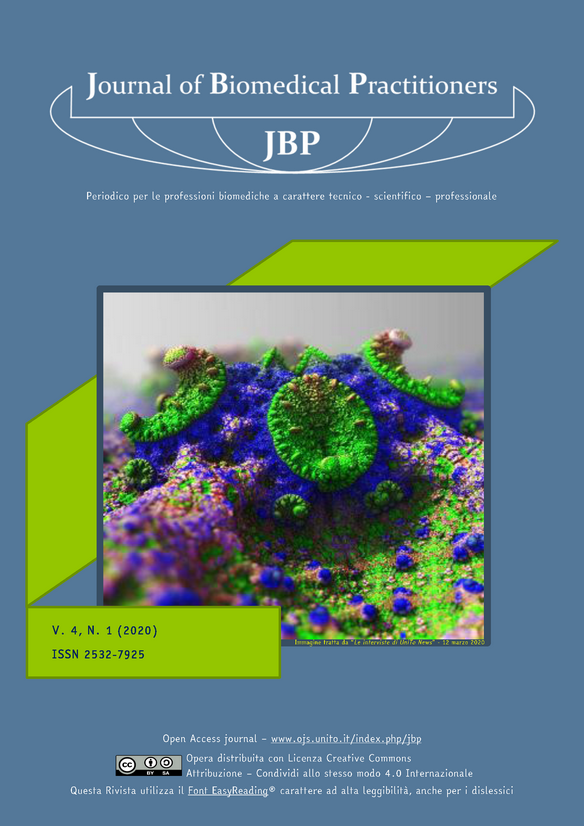Preliminary low-dose hybrid imaging protocol scan optimization in single photon emission computed tomography
Main Article Content
Abstract
Background and aim
The CT component of SPECT/CT is required for attenuation correction (AC) and anatomical localization (AL) in SPECT/CT imaging.
The aim of this preliminary study is to evaluate quantitatively the image quality of different low-dose CT protocols for AL-AC, in order to reduce the patient’s radiation exposure while keeping the interpretation unchanged.
Material and methods
Using the 16-section CT component of a commercially available SPECT/CT scanner, we compared the standard protocol indicated by application specialists (main parameters: 120kV, 80mA, 0.8s, pitch 1.37) with different CT scans acquisitions with manually adjusted x-ray tube voltage (kV range 100-140), anode current (mA range 40-100), rotation time (s range 0.5-1), and pitch (p range 0.938- 1.75).
The imaging performance of the CT system was evaluated using Cathpan 600 phantom (Phantom Laboratory, Salem, NY, USA). We evaluated uniformity (U), contrast-to-noise ratio for objects with nominal contrast of 1% (CNR1%), spatial resolution (SR) and CT linearity (L). The Volume Computed Tomography Dose Index (CTDIvol) was registered by the scanner software and compared with the different scanner acquisitions.
Results
The results of standard protocol results were U=0.46 HU, CNR1%=1.37, CNR0.5%=0.98, SR= 7 line pairs/cm, L=0.998 and CTDIvol=4.12mGy.
The results of experimental protocols (24 acquisitions), expressed as mean, standard deviation and minimum-maximum, were U= 0.48±1.11 (0.02-2.51) HU, CNR1%=1.28±0.4 (0.39-2.08), SR= 7 line pairs/cm, L=0.998±0.001 (0.993-0.998) and CTDIvol=3.81±1.73 (1.29-7.44) mGy.
An analysis of the data identified the combinations of scan parameters that have image quality comparable to the standard acquisition protocol for correcting the attenuation and anatomical localization, obtaining a significant reduction in the CTDIvol.
Conclusion
The different settings of tube voltage, anode current, scan time, and pitch allow to reduce the CTDIvol up to -37.9% for AL and AC purposes, maintaining an image quality comparable to the factory protocol. Further studies should be performed to verify the effect on attenuation map of the reduced kV, using an anthropomorphic phantom.
Keywords: Hybrid imaging, nuclear medicine, CT, phantom, attenuation correction.
Downloads
Article Details
The authors agree to transfer the right of their publication to the Journal, simultaneously licensed under a Creative Commons License - Attribution that allows others to share the work indicating intellectual authorship and the first publication in this magazine.
References
[2] Bailey DL, Pichler BJ, Guckel B, et al. Combined PET/MRI: Global Warming-Summary Report of the 6th In-ternational Workshop on PET/MRI, March 27–29, 2017, Tubingen, Germany. Mol Imaging Biol 2018;20(1):4–20
[3] Mariani G, Bruselli L, Kuwert T, et al. A review on the clinical uses of SPECT/CT. Eur J Nucl Med Mol Im-aging 2010;37(10):1959–1985
[4] Gatidis S, Beyer T, Becker M, Riklund K, Nikolaou K, Cyran C, Pfannenberg C. State of affairs of hybrid im-aging in Europe: two multi-national surveys from 2017. Insights Imaging. 2019 May 21;10(1):57. doi: 10.1186/s13244-019-0741-7.
[5] Salvatori M, Rizzo A, Rovera G, Indovina L, Schillaci O. Radiation dose in nuclear medicine: the hybrid ima-ging. Radiol Med. 2019 Aug; 124(8):768-776.
[6] Norma CE Report 91: Criteri di accettabilità per gli impianti radiologici e di medicina nucleare – 1997
[7] Yu, L., Bruesewitz,M. R., Thomas, K. B., Fletcher, J. G., Kofler, J. M. and Mccollough, C. H. Optimal tube potential for radiation dose reduction in pediatric CT: principles, clinical implementations, and pitfalls. Radiographics (2011). Available on: http://radiographics.rsna.org/content/31/3/835.full.pdf
[8] Nagel, H. D. CT Parameters that influence the radiation dose. Radiat. Dose Adult Pediatr. Multidetector Comput. Tomogr. Chapter 3 (2007). ISBN 978-3-540-28888-6.
[9] Chan, M., Yang, J., Song, Y., Burman, C., Chan, P and Li, S. Evaluation of imaging performance of major image guidance systems. Biomed. Imaging Interv. J. 7(2), e11 (2011).
[10] AAPM Report n. 39 (1993) Specifications and acceptance testing on computer tomography scanners. Ameri-can Institute of Physics in Medicine
[11] Van de Casteele, E., Parizel, P. and Sijbers, J. Quantitative evaluation of ASiR image quality: an adaptive statistical iterative reconstruction technique. In: Pelc, N. J., Nishikawa, R. M. and Whiting, B. R., Eds. (2012) Feb 23; 83133F-83133F-5. Available on: http://proceedings.spiedigitallibrary.org/proceeding.aspx?doi=10.1117/12.911283
[12] Tang, K., Wang, L., Li, R., Lin, J., Zheng, X. and Cao, G. Effect of low tube voltage on image quality, radi-ation dose, and low-contrast detectability at abdominal multidetector CT: phantom study. J. Biomed. Bio-technol. 130–169 (2012). Available on: http://www.pubmedcentral.nih.gov/articlerender.fcgi?artid=3347747&tool=pmcentrez&rendertype=abstract
[13] Zarb, F., Rainford, L. and McEntee, M. F. Developing optimized CT scan protocols: phantom measurements of image quality. Radiography 17(2), 109–114 (2011).
[14] Chan, M., Yang, J., Song, Y., Burman, C., Chan, P and Li, S. Evaluation of imaging performance of major image guidance systems. Biomed. Imaging Interv. J. 7(2), e11 (2011).
[15] Jacobs C. Optimization of CT calcium scoring doses on the General Electric Discovery single-photon emis-sion computed tomography/CT D670, 8-slice scanner. BJR Case Rep. 2016; 2:20160023.
[16] Grosser OS, Kupitz D, Ruf J, Czuczwara D, Steffen IG, Furth C, Thormann M, Loewenthal D, Ricke J, Amthauer H. Optimization of SPECT-CT Hybrid Imaging Using Iterative Image Reconstruction for Low-Dose CT: A Phantom Study. PLoS One. 2015 ;10:e0138658.

